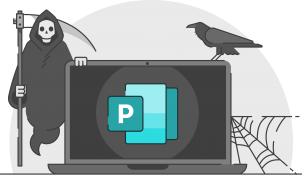‘We need to get the experts in’. It sounds impressive doesn’t it? It sounds like the A-Team are going to come crashing into your office and save you from almost-certain death. But ‘Quick! I need to call a PowerPoint expert!’ doesn’t quite conjure up the same image. More and more companies are outsourcing tasks they don’t have internal expertise for, but should presentations be on that list? We look at the pros and cons of PowerPoint outsourcing versus using your in-house design agency.
The Malaysia Tourist Board is the latest corporation to come under fire from graphic designers the world over for having their logo designed in-house, rather than outsourcing to a team of professionals. It’s a classic case of: ‘it cost nothing to develop the logo, but we’re not expecting it to win any design awards, we just want something that does the job.’ True, in-house design may be cheap, but is it cost-effective? Is in-house design actually doing you more harm than good and putting a cork in your sales pipeline?
Logo design is one thing, and most people would argue that outsourcing to specialists rather than leaving it to all-rounders is a given – after all it’s not something you’re going to change every week. But what about presentations? Assigning budget to outsource PowerPoint creations to experts surely isn’t justifiable: you make too many, they have to be done quickly, they seem to be successful as they are, will an external agency understand your needs well enough? Well, here are 6 things to consider, before you send your next presentation to your in-house design team.
Credibility
Imagine if a big multi-national company let non-web-specialists design their website. You arrive at the site and it doesn’t look great, it doesn’t work very well, so you don’t trust it and look elsewhere. Why is it any different with presentations? It’s not that you won’t trust someone with a bad presentation – and a bad presentation can be anything from too much text, too little animation, too many bad stock photos, to style over substance, gimmicks, and graphics that distract – but you will be much more likely to trust someone who has a deck that has been designed by professional presentation designers.
It’s not that your designers aren’t good, it’s just that they’re not presentation experts – and I imagine specifically not PowerPoint experts. When your competitors are clamouring for attention, you want to give your prospects as much reason as possible to trust you and not them. Which takes us to our second point…
Competitive advantage
If all of your competitors have bought into the idea that in-house presentation design ‘will do’ for now then you have a level playing field. However, as soon as someone decides to take the plunge and invest in PowerPoint outsourcing, you’ll be left dead in the water. Even if your story is better, you’ll have to do so much more to win them over.
You’ll be battling the ‘Death by PowerPoint’ vibes, whilst they’ll be enjoying the ‘is this even PowerPoint!’ comments. Don’t let bad PowerPoint detract from your message.
Scalability
It might be that you can create half-decent slides in your team because you have a PowerPoint Whisperer on board. But this isn’t a scalable solution, and it isn’t future-proof. Not only will that person have other things to take care of, but tying that responsibility to one, or even a couple of people, gives you a single point of failure, and increased risk as a result.
Even if you can get by with this set-up, it may be limiting you: you may have reached a stage where your slides aren’t doing harm, but you will naturally be limited by what your in-house team can do in the time they have.
Outsourcing PowerPoint creation and working with professional presentation designers – people who are experts in all things PowerPoint – means you can manage peaks in demand. It’s likely that when you have an urgent presentation due, it’s down to a product or campaign launch, so your designers will definitely have their hands full elsewhere. Spreading the workload – and giving it to the professionals – means you get a scalable solution without quality taking a hit (in fact it will make it better).
Time
If you don’t have a team of specialists working in-house – people that just make great slides all day every day – then it’s going to take longer to create something even half of the same quality. Your team of non-specialists will potentially be spending important business hours on tasks that they just don’t have the expertise for: save them for the work they’re good at, and outsource PowerPoint presentations to the specialists.
Editability
PowerPoint is not universally loved, and many designers will do their best to avoid it at all costs. This means the slides you get from your in-house team are likely to have been built elsewhere and brought into PowerPoint at the last possible moment. It might be that your graphics are all pictures and can’t be edited, it might be that the whole slide is a picture and can’t be edited. The bottom line, however, is that if your reps want to make edits they either can’t (and risk presenting outdated or irrelevant content) or can, but badly (and risk presenting horrible slides that look like they’ve walked out of the pages of a Mary Shelley novel).
If you don’t want to risk your reps presenting content that damages your credibility, then you need to give them something that they can edit, but not break. A PowerPoint expert will make sure you get beautiful slides that are easy to edit.
Presentability
I wonder how many designers that make slides in-house actually have to present them. My guess is that it’s very few. Only when you present content on a regular basis, do you realise what makes slides easy to present. Things like animation and clear hierarchy help to pace the flow of information and make slides easy to digest for an audience; their brain power isn’t taken up with trying to figure out points on a detailed diagram, or where an in-depth process or structure starts.
If you don’t have the expertise to design well and use the best of PowerPoint’s features to help you bring it to life, then your message will suffer as a result. Often companies present horribly complicated slides with no animation, because they’re not sure how to do it well. Or instead of creating a slide with explanatory visuals, they use bullet points to cover the main highlights. In both cases it opens the way up to confusion and the audience tuning out, instead of engaging with your message on a deeper level.
PowerPoint outsourcing means your message will never suffer as a result of your visual content, because professionals are experts at getting message and visuals to work together in perfect complementary harmony. And an added bonus is that your reps will find slides much easier to present as well. Oh, and your audiences will thank you as reps no longer read out entire paragraphs on the slide because the text will have been replaced by a stunning visual sequence.
So what now: PowerPoint outsourcing solutions to explore
So if these are the hidden costs that designing with an in-house team of non PowerPoint experts, what are the options?
- Bite the bullet: If you think that the hidden costs outweigh the investment then try PowerPoint outsourcing out. Get in touch with a professional presentation design agency full of PowerPoint experts (we can recommend one if you like) and have a chat about what they can offer. If it’s bells and whistles, start-from-scratch stuff, you might be looking at a creation package; if it’s just a design and animation spruce, then something more akin to revamping your slides might be up your street.
- Get the right tools: Another option could just be to give your team the tools they need to do the job well. A presentation toolkit will give you the bits you need to make great slides without having to call the experts every time. PowerPoint training will make sure your team gets the most out of everyone’s favourite presentation software.
- Risk it: Keep on keeping on for now is always an option, but keep an eye on what your competitors are doing and when they make the jump to getting professional help with their presentations.
How does PowerPoint outsourcing apply to training presentations?
I was in a training presentation recently and whenever the speaker said something noteworthy, instead of the audience making notes, they photographed the slide. You should treat your external training content as marketing material. A charismatic and engaging presenter will be worth nothing if the audience member looks back after the event and sees they have seven photographs of bad PowerPoint slides.
Internal content is a little different, but the same principles of credibility and getting your audience on board early apply. If you have a high stakes internal presentation to make, consider getting help to make sure you’re saying what you need to, with visuals that will enhance your message.
It’s also important to get buy-in from your audience with internal training. If you intend to bring about behavioural change, or upskill a department in a particular area, you’ll need the audience to engage effectively with your content. Having slides that look great is a starting point. Having slides with visual sequences that consolidate the message are worth their weight in gold.
In-house design teams are invaluable to companies, but the trick is to get them doing what they’re good at and handing over everything else to specialists – that includes outsourcing PowerPoint creation. Having said that, it is possible to become a PowerPoint expert and master its dark arts. It’s always worth checking out our events page to see if there are any of our free masterclasses, or in-person training events coming up that can help upskill your team.
Comments or questions? Pop them below and let’s start the discussion.
Leave a comment




